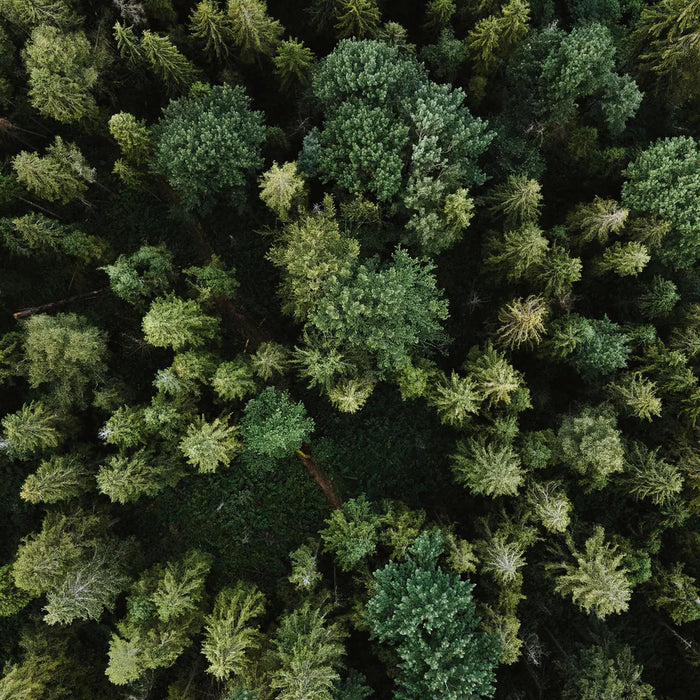Environmental and ethical factors are one of the most expansive talking points in the laboratory grown and natural diamond discussion. With so many different practices of retrieving natural diamonds from the earth to consider, and with the very new industry of synthetic diamonds (otherwise known as laboratory grown) thrown in, the conversation is certainly multilayered. So where do we begin?
KEY TAKEAWAYS
- Focus on the ethos and transparency of the diamond company rather than simply whether they're natural or lab grown
- Ocean Diamonds, CanadaMark and Botswanamark are the gold standard in natural diamond transparency
- Industry definitions recognised by UK Trading Standards help you to buy with confidence
- Research is key to empowering you in your decision - we recommend studies to help inform you.

Natural Emerald Cut Diamond
ALLUVIAL VS. MINED DIAMONDS
Natural diamonds can be broken down into two categories: the first is alluvial, meaning they’re recovered from the surface of the earth in deposits of sand, gravel and clay, and the second is mined diamonds that are found in kimberlite pipes deep beneath the surface of the earth.
Alluvial diamonds when sourced through the correct channels can be an environmentally conscious and ethically rigorous choice, even when compared to lab grown. Our favourites are Ocean Diamonds.

Image credit: Ocean Diamonds
OCEAN DIAMONDS
As well as their minimal impact to the earth - no greater than that of a small scale fishing boat - Ocean Diamonds keep as many of the processes within the local communities of Namibia and Western Coast of South Africa to support the communities there. Not to mention that every diamond is fully traceable from the ocean bed to the finished ring.
Learn more about the incredible work they do here.
NATURAL MINED DIAMONDS
While the natural mined diamond industry has had a rather more rocky trajectory, it has been under intense speculation since the early 2000's and as a result stringent practices have been put into place to protect the workers and environment.

WHAT ARE THEY DOING?
Here are some of the ways in which diamond mining companies are reducing their impact (World Diamond Council Fact Sheet)
- Implementing renewable energy programmes, including hydroelectric power and solar energy
- Limiting water usage and recycling their waste water to use again
- Harvesting and replanting seeds of native plantlife around mines to protect biodiversity
- Keeping the diamond economy in countries that rely heavily on it for income
CanadaMark and Botswanamark are renowned for their strict standards that go above and beyond governmental mining regulations, and are -along with Ocean Diamonds - the best choice in our opinion if you're looking for a new natural diamond.

Botswanamark at the RB showroom
THE NUMBERS
When comparing CO2 emissions, natural diamonds can emit 160 kg of CO2 per cut and finished carat (2019 Natural Diamond Council report) while laboratory grown diamonds can emit anywhere between 523 and 612kg of CO2 per cut and finished carat, although this drops significantly when renewable energy is used (Sphera).
WHY THAT'S A PROBLEM
Focusing on carbon emissions can skew the results as there are many other factors that affect the environmental impact of a diamond and positive schemes that are implemented to offset these impacts.

Our Rosa Ring set with a 2.53ct laboratory grown diamond
OUR RECOMMENDATION
So what does this mean for our clients? If you’re choosing your diamond based solely on environmental factors, it’s can feel like there’s a lot to navigate. Research from reputable sources is key to informing your decision: we’ve found these particularly helpful if you’re choosing your diamond based solely on environmental factors:
- - Sphera’s Study
- - World Diamond Council Diamond Facts
- - Imperial College London Consultant Report
- - GIA
We’ve also created a guide to choosing a diamond with the least environmental impact here.
UK MARKET REGULATIONS
There’s good news for the UK market too. In 2020 The National Association of Jewellers (NAJ), together with nine of the leading diamond industry organisations, endorsed a Diamond Terminology Guideline that’s recognised by UK Trading Standards. It ensures that there is clear terminology used when selling diamonds - for example, the word ‘real’ should not be used in reference to laboratory-grown diamonds. It’s not to say that this doesn’t happen, but having regulations in place ensure that customers are less likely to encounter advertising with unsubstantiated claims and incorrect wording.

Natural Oval Cut Diamond Bespoke Ring
In America, the Federal Trade Commission has issued notices of warning to laboratory-grown diamond companies over unsubstantiated claims, while the National Advertising Division has made recommendations to the National Diamond Council to revise the wording in their report, which means that both the natural and laboratory-grown diamond industries are being closely watched.
THE FINAL WORD
This is all to say that those who opt for a diamond can choose theirs with greater confidence with the knowledge that diamond industries are being watched and regulated.
Our team are always on hand to help with your decision - book in for your complimentary initial consultation here.



















